Product feedback is how you improve your product—it’s as simple as that. It’s the key to uncovering product wins and losses—and an essential part of your product development.
In this guide, we’ll take a closer look at various types of product feedback, why you need a feedback loop, and what tools are best cut out to help you gather, analyze, and implement product feedback. Let’s get this show on the road.
What is product feedback?
Product feedback is anything and everything your customers have to say about your product. It can be as simple as ‘love it, the dashboard’s super intuitive’, or as complex as short essays from disgruntled users who can’t find the support button.
Product feedback is key for adapting and improving your product, marketing, support, and more. Put simply, product feedback is your golden egg.
It isn’t a one-and-done, however—you want to continuously collect feedback to keep a close eye on the direction of your product. Let’s take a look at how you can collect timely and relevant feedback from your users.
How to continuously collect product feedback
You know what they say—good things don’t come easy. Product feedback is a continuous effort, but your business will be better for it.
There are ample ways to collect valuable insights—and we highly recommend you gather and analyze multi-channel feedback. Using a mix of surveys, user interviews, focus groups, and usability testing will give you a comprehensive overview of how users think and feel about your product.
For the best view of your product, you’ll need to continuously collect user feedback. This helps you not only monitor your product as it grows, but also understand how successfully you’re implementing feedback. If you change something following feedback, and users still don’t like it—you’ve missed the mark.
Let’s take a closer look at the methods you can use to collect user feedback.
Product feedback surveys
How could we talk about product feedback without talking about product surveys? They’re a go-to for many businesses when collecting feedback—and it’s not without reason.
When you run surveys in-product, it gives you the chance to ask your customers specific, contextual questions, without the pressure or accountability of an in-person interview or a focus group.
Plus, there are many types of surveys for many types of feedback:
Net Promoter Score (NPS) survey: the NPS survey helps measure the loyalty of customers to your company. Typically, you’ll ask a single question: How likely are you to recommend our company? Respondents give a rating between 0 (not likely) and 10 (extremely likely), with their final score assigning them to one of three categories: Detractors (0-6), Passives (7-8), and Promoters (10-9). And here’s the formula to calculate your NPS score.

Customer Satisfaction (CSAT) survey: the CSAT survey helps determine how satisfied your users are with your product, specific feature or functionality, or your overall brand. Users rate satisfaction on a scale of 1-5. Sometimes this is a single question at the end of a survey, other times it’s a deep dive into customer satisfaction with specific features.
Customer Effort Score (CES) survey: the CES survey helps understand how difficult or easy users find your product. In other words, how much effort they need to put into completing tasks. It’s typically an in-product survey that collects contextual feedback from users interacting with the product. Here’s an example of what it can look like.
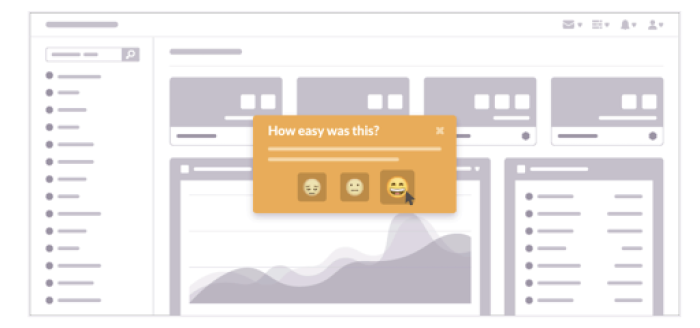
Consistently creating and sending out user surveys is key for measuring your ongoing success. It’s also essential to consider not only the questions you ask, but how you ask them.
Understand what you’re looking to find before creating your survey, and ask narrow questions to get the answers you want—whether it’s positive or negative feedback. Be intentional with your surveys—aimless survey questions don’t get you the valuable insights you want.
For more on this topic, check out our article on how to run user surveys in the age of product-led growth 👇
User interviews
User interviews are a great way to gather qualitative feedback. It’s essentially a structured chat with a customer about their experience using your product.
User interviews give you the chance to dig deeper into your users' thoughts and feelings, and better understand the user experience. Continuously conducting user interviews—whether that’s for 10 minutes or an hour—enables you to keep a close eye on how customer sentiment is evolving with your product.
It’s also a great UX research method and a way to discover more about support requests—what exactly are customers looking for from new features and updates? A conversation gives you the space to develop a deeper understanding of your customers' needs.
Focus groups
Focus groups are another way of collecting user feedback. They involve gathering a select group of individuals from a specific audience segment to discuss your product and its features.
For example, it can be a group of product managers discussing how they use your platforms.
Your focus group sessions can be recorded for viewing at a later date, and can also submit feedback forms following the discussions.
Usability testing
Usability testing involves testing your product with existing or prospective users, and gathering in-app feedback from the various issues they encounter. The goal is to develop insights into how easy or difficult your product is to use.
Consistently running usability tests enables you to pinpoint and prioritize certain issues and their solutions. It also allows you to evaluate whether improvements are hitting the mark—or whether you need to reconsider your approach.
Continuously gathering feedback ensures you’ve always got an up-to-date snapshot of your product that enables you to better respond to customer requests and meet customer needs.
Product feedback loops and why you need them
The product feedback loop refers to the process of gathering feedback and implementing data-driven improvements. It’s an ongoing cycle that revolves around building, measuring, and learning.
One of the best-known feedback loop strategies is the ACAF framework–referring to Asking, Categorizing, Acting, and Following up. In their article, HubSpot explains how the ACAF customer feedback loop works and provides a step-by-step approach to gathering, sharing, and implementing customer feedback. Let’s take a look:
Ask for feedback: If you don’t ask, you don’t get it—right?
Categorize the feedback: You need to know how you’ll use your data in order to avoid getting lost in it.
Act on feedback: Make the changes your customers want from your product.
Follow up: Find out whether dissatisfied customers are happy with the changes.
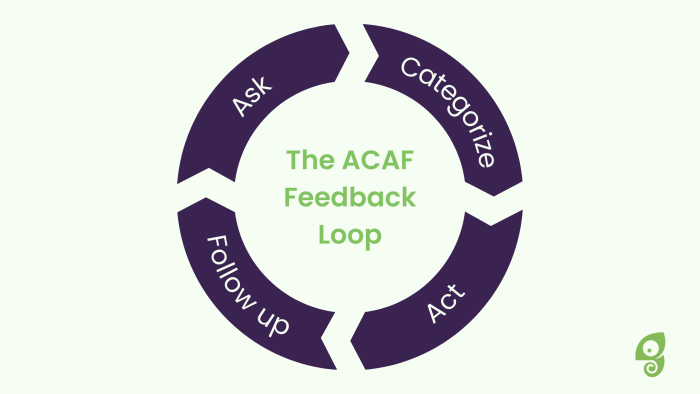
Using this process to implement feedback allows you to not only measure your success, but also engage users by involving them in the development process. If that wasn’t enough, here are three reasons you need a customer feedback loop.
1. Use product feedback loops to understand and meet customer needs
Product feedback helps you understand what your customers want and need from your product. Through a combination of feedback collection methods, you can get a comprehensive view of what your customers think of your product.
By implementing product feedback loops, you can continue to develop your product so that it best fits your users' needs. Plus, involving users in the feedback loop enables them to feel included—creating valuable power users that are loyal to your product.
2. Use product feedback loops to shape your product roadmap
Collecting user feedback for roadmap development helps you prioritize certain issues over others. It can help you uncover pressing issues you weren’t aware of, as well as identify quick fixes that create a big impact.
A product feedback loop enables fast-paced changes for agile teams. Constantly having your finger on the pulse ensures you’re guiding development in the right direction—both in terms of immediate changes and the long-term direction of your product.
3. Use product feedback loops to accomplish strategic goals
Customer feedback enables product-led growth teams to accomplish strategic goals by sharing insights to improve the five key business metrics: acquisition, activation, retention, referrals, and revenue.
Feedback loops enable you to identify key areas for improvement that could be affecting your overall business health. Feedback loops enable you to focus on a number of metrics at a time. This can provide valuable information for improving key business metrics.
We asked Vino Jeyapalan, CEO and co-founder at Kabo, about how they use product feedback to improve their service:
“We collect customer feedback at post-purchase, cancellations, and during calls with our Pet Health Experts. For example, when a customer cancels we are able to understand if they are churning due to price or product-market fit. By doing this we quickly learned our packaging needed to be easier for storage and feeding allowing us to reprioritize this and improve retention.”
– Vino Jeyapalan, CEO and co-founder at Kabo
Continuous feedback ensures that your chosen plan of action is the right one—if customers aren’t complaining about the issues they previously had, you’ve successfully implemented feedback.
Let’s take a look at the types of feedback you need, before looking into the tools that can help you gather and analyze it.
Close the circle with solicited and unsolicited feedback
The customer health score is a metric largely used by customer success teams to determine whether customers are healthy or at risk. The exact method of determining customer health score varies from company to company, but it’s typically composed of solicited and unsolicited feedback.
Solicited feedback: This is the feedback that you ask for. You develop the questions with the goal of gathering insights on a specific product or feature, and ask customers for their thoughts. Surveys, interviews, and focus groups are all types of solicited feedback.
Unsolicited feedback: This is the feedback that you receive organically. It’s feedback given by users without prompt, and it includes things like social media insights, user reviews, customer support tickets, and feedback from customer forums.
Together, solicited and unsolicited feedback make up your circle of customer health and provide insights that enable you to make better product decisions.
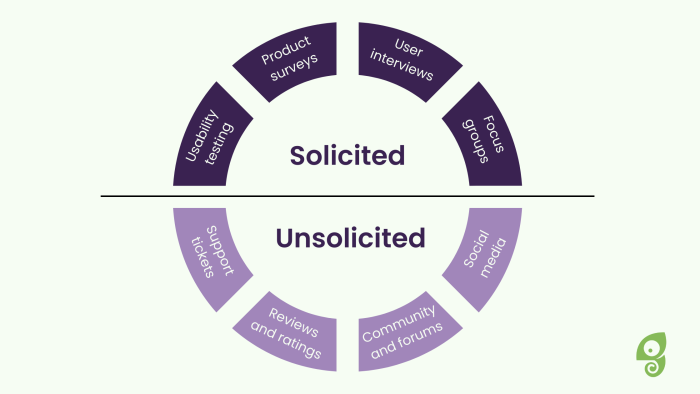
Product feedback tools to help you execute your strategy
In order to effectively collect product feedback, you’re going to need some pretty powerful tools. Otherwise, you risk feedback turning into an overwhelming amount of data.
Here are some tools—separated by use case—to help your team make the most of your product feedback.
In-product feedback tools
In-product feedback tools allow you to gather feedback from users while they’re interacting with your product. This is one of the most efficient ways to get a sense of user thoughts, needs, and pain points.
For this purpose, you can use Chameleon to gather continuous, segmented feedback throughout the user lifecycle.
For example, you can run Microsurveys to personalize the onboarding experience, measure your NPS, CES, and CSAT score, or ask users for their opinion on a new feature you just launched. Here’s an example of what it could look like.
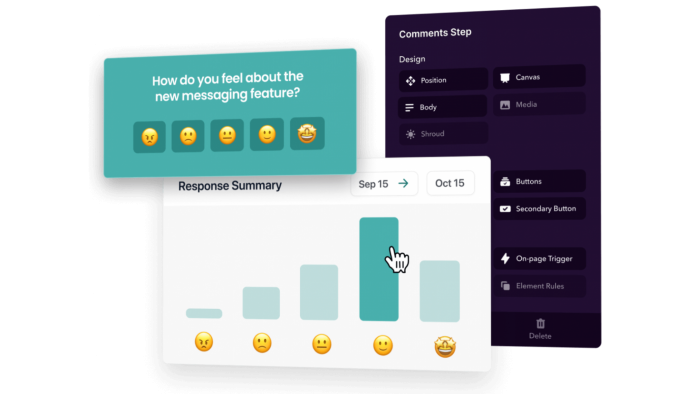
In-product surveys will help you meet users where they are and quickly get insights. From there, you can act on the feedback and use Tours or Launchers to guide users through in a personalized manner.
Here are more tools that can help you with in-product feedback:
UserGuiding: You can gather and implement feedback through NPS surveys, hotspots, analytics, and more.
Userpilot: Enables you to collect product feedback with surveys, identify common themes, and organize feedback.
Intercom: Intercom has recently introduced Intercom Surveys as an addition to their product. You can use these for in-app feedback and lead generation.
Refiner: By building in-app and email survey campaigns, you can create feedback loops and use analytics to discover actionable insights.
User research tools
User research involves gathering product feedback from your target users in order to expose issues and create solutions. User research can develop both qualitative and quantitative data that you can use to develop your product.
Here are some tools to consider:
User Interviews: This tool connects researchers with participants for user interviews. You can target by profession, location, demographics, and more to find participants that best represent your target users.
UserTesting: Enables you to get quick feedback from real users through customer experience narratives. Put simply, you provide a list of tasks to be completed with your product, and UserTesting connects you with participants who complete the task—giving feedback as they go via a recording.
Behavior feedback tools
Behavior feedback tools gather feedback by monitoring how users interact with your product. This could be visualizing user behavior with heatmaps, or monitoring rage clicks to measure user frustration.
Here are some tools to help with gathering behavior feedback:
FullStory: Gives you a comprehensive overview of your users’ digital experience. You can monitor rage clicks, error clicks, active time, and more to dive deeper into how your users engage with your product.
Hotjar: This tool enables you to understand how users behave on your site, what they need, and how they feel. It provides a wide variety of features, including heatmaps, screen recordings, and surveys.
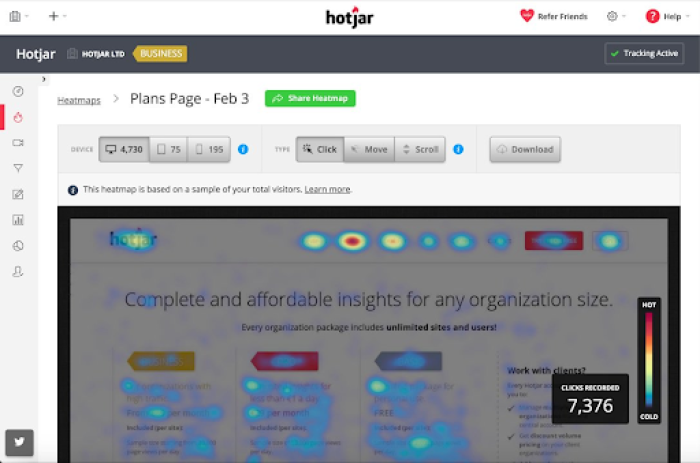
Product analytics tools
Product analytics tools enable you to analyze the feedback you receive to better implement solutions and changes. It allows you to sort feedback into the big picture, specific flows, and individual user journeys for understanding your product at all levels.
Here are some tools to consider for your feedback analysis:
Mixpanel: Enables you to gather and analyze user feedback with both qualitative and quantitative product usage data. You can create insight reports to find power users, funnel reports to find conversion rates, and retention reports to see which types of users stick around. Here’s an example of a report made with Mixpanel. You could also integrate Mixpanel with Chameleon to combine data for a better understanding of your users' needs.
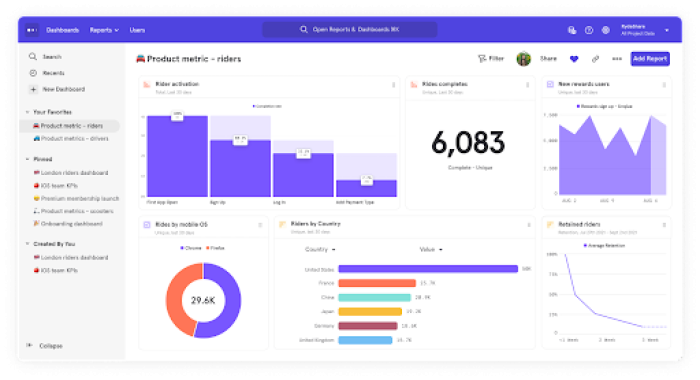
Heap: With this tool, you can analyze user feedback to help you drive product-led growth through user acquisition, activation, engagement, retention, and expansion. Its integrations with customer engagement platforms and digital adoption platforms help you to quickly act on the insights you discover. For example, you can use a two-way integration with Chameleon to analyze data and quickly improve the product experience based on the insights.
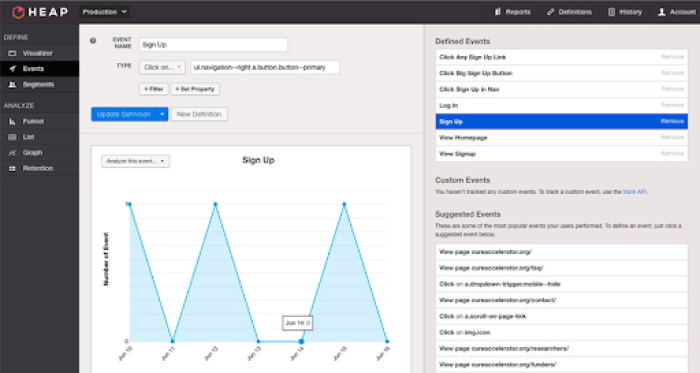
The bottom line: Product feedback requires a full suite of tools to gather and analyze your customer’s thoughts and feelings. Use your chosen product feedback tools together, and consider how they fit into your existing workflow.
A wrap-up on product feedback and why you need it
Product feedback should inform the direction of your product—these approaches and tools will help you determine where to start.
One thing’s for sure—once you do start it’s essential to keep going. Product feedback loops move you closer and closer to where your product needs to be and enable you to slowly but surely increase your customer lifetime value.
Remember, you’re creating a product to meet user needs—fully understanding those needs is an absolute must for your product.
Get user feedback with Chameleon
Run in-product surveys to collect contextual user feedback throughout the development process – from ideas to validation to deployment.




